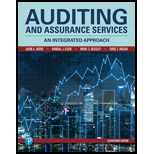
Indicate the purpose of risk assessment procedures and how do they differ from the four other types of audit tests.
Explanation of Solution
Risk Assessment Procedures:
The procedure of study and evaluation of all sorts of risk in management is known as the risk assessment procedure. An auditor uses it to analyze the efficiency and effectiveness of the internal
Purpose of risk assessment procedure:
An auditor uses the risk assessment procedure for determining the control program and evaluate the risk. Its purpose is:
- To assess the risk of misstatement in the financial statements and efficiency of an internal control system of concern.
- To make and maintain a culture of risk awareness.
- To market a risk-aware organization through assessment.
- To determine the nature of risk.
- To test the efficiency of the internal control system of the client.
- To evaluate possible misstatements in final statements.
Steps of risk assessment procedure:
- Classify the threats: The first step is to determine all possible risks based on observation.
- Resolve what, or who could be harmed: The second step is to consider all possible components that may harm them in any manner.
- Assess the risk and establish control measures: The third step is to determine the risk and take necessary control measures for bringing efficiency in records.
- Enumerate the findings: The last step is to enumerate risk and classify them as per the requirements of the test procedure.
- Analyze and update the risk assessment frequently: Analyze and update the risk assessment on regular basis.
Types of tests: The five kind of audit tests auditor use to determine whether financial statements are adequately declared are: risk assessment procedures, tests of controls, substantive tests of transactions, substantive analytical procedures, and tests of details of balances.
Risk assessment procedure differs from the four other types of audit tests:
- In the risk assessment procedure, the evidence is examined only by ascertaining a couple of transactions through the system. In testing, the auditor assesses sufficient evidence.
- In the risk assessment procedure, evidence assesses the inquiry. In testing, queries are not satisfactory.
- Risk assessment procedure comprises inspection, detailed process, analysis, and examination. Tests of controls involve related processes but also comprise re-performance of control.
- The risk assessment procedure is enforced at the beginning of an audit. Test of controls are implementing throughout the examination.
Conclusion: The purpose of risk assessment procedures is to appraise the possibility of misstatement within the financial statements. By analyzing the character of risks, these actions help the auditor to decide the extent on the contrary audit steps to be organized. This procedure helps the auditor to regulate how the organization behaves and the risks it is defined to, these procedures used to obtain considerate of internal control.
Want to see more full solutions like this?
Chapter 13 Solutions
Auditing And Assurance Services
- What are the different types of analytical procedures? Describe how they may be utilized in an audit as substantial tests.arrow_forwardWhat are the overall categories of Auditing procedures, briefly explain them?arrow_forwardWhat are the benefits of subtantive test of transactions in auditing?arrow_forward
 Auditing: A Risk Based-Approach (MindTap Course L...AccountingISBN:9781337619455Author:Karla M Johnstone, Audrey A. Gramling, Larry E. RittenbergPublisher:Cengage Learning
Auditing: A Risk Based-Approach (MindTap Course L...AccountingISBN:9781337619455Author:Karla M Johnstone, Audrey A. Gramling, Larry E. RittenbergPublisher:Cengage Learning Auditing: A Risk Based-Approach to Conducting a Q...AccountingISBN:9781305080577Author:Karla M Johnstone, Audrey A. Gramling, Larry E. RittenbergPublisher:South-Western College Pub
Auditing: A Risk Based-Approach to Conducting a Q...AccountingISBN:9781305080577Author:Karla M Johnstone, Audrey A. Gramling, Larry E. RittenbergPublisher:South-Western College Pub


